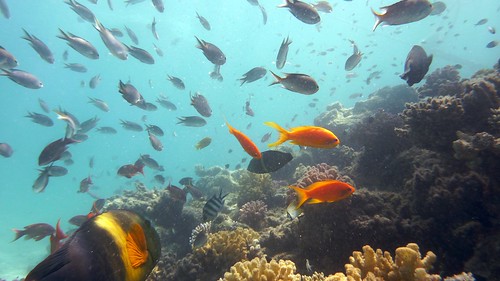 Marine protected areas (MPAs) are part of the management toolbox that can ensure sustainable use of the oceans and provide the world with fish proteins. Yet, even as benefits of MPAs related to food security, ecosystem services, and livelihoods are known, we currently fail on our commitments to protect 10% of the oceans by 2020.
Marine protected areas (MPAs) are part of the management toolbox that can ensure sustainable use of the oceans and provide the world with fish proteins. Yet, even as benefits of MPAs related to food security, ecosystem services, and livelihoods are known, we currently fail on our commitments to protect 10% of the oceans by 2020.Perhaps we need to look at the problem through a new angle: what if you woke up one day and all the oceans were protected? From now on, ocean users would have to make their case to convince governments of their need to have space allocated for their activity.
I like to imagine that I wake up one day and all the Coral Triangle oceans and coastal ecosystems were managed in a large MPA with multiple sustainable use zones and with 30% of the coastal areas and oceans as no-take reserves (the Coral Triangle includes tropical marine waters of Indonesia, Malaysia, Papua New Guinea, Philippines, Solomon Islands and Timor-Leste). If that were to happen, what would the marine-based economies, livelihoods, and conservation work throughout the Coral Triangle look like?
The many competing users of the marine environment and its resources would need to convince governments of their need to have “space” allocated for their activities, be it fishing, fish farming, shipping, oil & gas exploration, recreation, and conservation, among others. Flipping the burden of proof and inverting resource governance would require people to demonstrate social benefits from extractive activities, above and beyond those already generated, with no impact (or positive impact) on ecosystem structure and function. Conservation would be the default, unless proven otherwise, and default property rights would sit with conservation rather than extraction.
While the benefits of MPAs related to preserving biodiversity, protecting commercially valuable species, replenishing depleted stocks, encouraging sustainable use, and providing a myriad of ecosystem services are well described, we struggle to understand why it seems so difficult for the Coral Triangle governments and countries worldwide to achieve the CBD commitments of having 10% of oceans and marine areas under protection or some form of management by 2020. Perhaps we need to flip the problem and create a new angle to an old debate.
A discussion panel – composed of representative from seafood industries, government representatives, conservation organizations – could reflect on things like:
Would advocates of intensified resource use run campaigns to convince the public and specific decision makers of the need for, and value of, being attributed a portion of the ocean for local and global societies?
Would they need to keep reminding governments of those existing laws and policies that are in support of economic development and responsible use of the oceans’ natural resources at international and national conventions and platforms?
Would multi-lateral economic and trade-related agencies play the role that conservation NGOs and multi-national conservation agencies such as IUCN currently have, and try to make their case at Rio in a small side session for a debate on use of the oceans?
Would ocean users be required to contribute to the “conservation first” approach? Would they need to go through long and inclusive participatory planning and negotiation processes to get access to a certain area for specific use?
Would they need to compensate for the lost conservation area through a variety of mechanisms, such as payment for management of an area of comparative conservation and environmental value of the ecological services provided by that area?
Would communities that live along coastlines and on islands be doing anything differently from what they do today? Would the specific designation of use areas provide additional livelihood and food security benefits that can be measured and evidenced as attribution compared to the provision of food and livelihoods from activities in the multiple-use zones of the Coral Triangle MPA?
Would governments monitor to ensure that users’ regulated activities are allowed, and that they are able to harvest fish in designated areas or can users actually be trusted to manage and ensure their use-rights themselves?
Would financial institutions consider the benefit of environmental restoration (growth) firstly and above the financial profitability of proposals for investment in infrastructure and economic development?
Even though this “30% no-take zone scenario” looks like science-fiction for now (as less than 2% of the oceans are currently protected and we are not even talking about no-take zones), the impact of such measures would go well beyond conservation benefits. Designating the entire Coral Triangle or indeed all our oceans as a well-managed MPA, with 30% no-take reserves and the rest in effectively implemented sustainable use areas would probably provide the global, regional, and local societies with the same (if not more) protein livelihoods and services as today. And if the entire world’s ocean realm was a well-managed MPA, we would not lose bit-by-bit those goods and services every year.
The outcome of such debate or “participatory play” could help identify and generate innovative mechanisms to motivate government, private sector, and civil society to take action for a more sustainable use of the oceans. Do you want to start this debate with me or go back to sleep?
Source: National Geographic
Image courtesy of ronaldhole via Flickr (CC BY 2.0)
